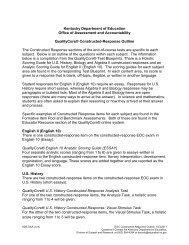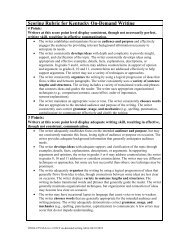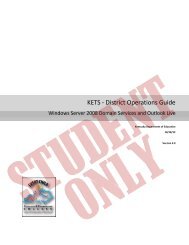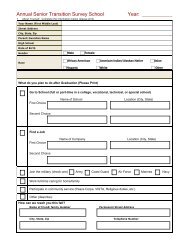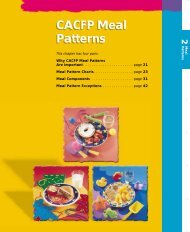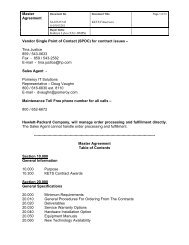Standards with Progressions grades K-HS v. 1.3 - Kentucky ...
Standards with Progressions grades K-HS v. 1.3 - Kentucky ...
Standards with Progressions grades K-HS v. 1.3 - Kentucky ...
- No tags were found...
Create successful ePaper yourself
Turn your PDF publications into a flip-book with our unique Google optimized e-Paper software.
The Real Number System N -RN<br />
Extend the properties of exponents to rational exponents.<br />
1. Explain how the definition of the meaning of rational exponentsfollows from extending the<br />
properties of integer exponents to those values, allowing for a notation for radicals in terms of<br />
rational exponents. For example, we define 51/3 to be the cube root of 5<br />
because we want (51/3)3 = 5(1/3)3 to hold, so (51/3)3 must equal 5.<br />
2. Rewrite expressions involving radicals and rational exponents using<br />
the properties of exponents.<br />
Use properties of rational and irrational numbers.<br />
3. Explain why the sum or product of two rational numbers is rational; that the sum of a rational<br />
number and an irrational number is irrational; and that the product of a nonzero rational<br />
number and an irrational number is irrational.<br />
Quantities★N -Q<br />
Reason quantitatively and use units to solve problems.<br />
1. Use units as a way to understand problems and to guide the solution of multi-step problems;<br />
choose and interpret units consistently in formulas; choose and interpret the scale and the<br />
origin in graphs and data displays.<br />
2. Define appropriate quantities for the purpose of descriptive modeling.<br />
3. Choose a level of accuracy appropriate to limitations on measurement when reporting<br />
quantities.<br />
The Complex Number System N -CN<br />
Perform arithmetic operations <strong>with</strong> complex numbers.<br />
1. Know there is a complex number i such that i2 = –1, and every complex number has the<br />
form a + bi <strong>with</strong> a and b real.<br />
2. Use the relation i2 = –1 and the commutative, associative, and distributive properties to add,<br />
subtract, and multiply complex numbers.<br />
3. (+) Find the conjugate of a complex number; use conjugates to find moduli and quotients of<br />
complex numbers.<br />
Represent complex numbers and their operations on the complex plane.<br />
4. (+) Represent complex numbers on the complex plane in rectangular and polar form<br />
(including real and imaginary numbers), and explain why the rectangular and polar forms of a<br />
given complex number represent the same number.<br />
5. (+) Represent addition, subtraction, multiplication, and conjugation of complex numbers<br />
geometrically on the complex plane; use properties of this representation for computation. For<br />
example, (–1 + √3 i)3 = 8 because (–1 + √3 i) has modulus 2 and argument 120°.<br />
6. (+) Calculate the distance between numbers in the complex plane as the modulus of the<br />
difference, and the midpoint of a segment as the average of the numbers at its endpoints.<br />
Use complex numbers in polynomial identities and equations.<br />
7. Solve quadratic equations <strong>with</strong> real coefficients that have complex solutions.<br />
8. (+) Extend polynomial identities to the complex numbers. For example,rewrite x2 + 4 as (x +<br />
2i)(x – 2i).<br />
9. (+) Know the Fundamental Theorem of Algebra; show that it is true for quadratic<br />
polynomials.<br />
Vector and Matrix Quantities N -VM<br />
Represent and model <strong>with</strong> vector quantities.<br />
1. (+) Recognize vector quantities as having both magnitude and direction. Represent vector<br />
quantities by directed line segments, and use appropriate symbols for vectors and their<br />
magnitudes (e.g., v, |v|, ||v||, v).<br />
<strong>Kentucky</strong> Department of Education<br />
2. (+) Find the components of a vector by subtracting the coordinates of an initial point from<br />
the coordinates of a terminal point.<br />
3. (+) Solve problems involving velocity and other quantities that can be<br />
represented by vectors.<br />
Perform operations on vectors.<br />
4. (+) Add and subtract vectors.<br />
a. Add vectors end-to-end, component-wise, and by the parallelogram rule. Understand that<br />
the magnitude of a sum of two vectors is typically not the sum of the magnitudes.<br />
b. Given two vectors in magnitude and direction form, determine the magnitude and direction<br />
of their sum.<br />
c. Understand vector subtraction v – w as v + (–w), where –w is the additive inverse of w, <strong>with</strong><br />
the same magnitude as w and pointing in the opposite direction. Represent vector subtraction<br />
graphically by connecting the tips in the appropriate order, and perform vector subtraction<br />
component-wise.<br />
5. (+) Multiply a vector by a scalar.<br />
a. Represent scalar multiplication graphically by scaling vectors and possibly reversing their<br />
direction; perform scalar multiplication component-wise, e.g., as c(vx, vy) = (cvx, cvy).<br />
b. Compute the magnitude of a scalar multiple cv using ||cv|| = |c|v. Compute the direction of<br />
cv knowing that when |c|v 0, the direction of cv is either along v (for c > 0) or against v (for c<br />
< 0).<br />
Perform operations on matrices and use matrices in applications.<br />
6. (+) Use matrices to represent and manipulate data, e.g., to represent payoffs or incidence<br />
relationships in a network.<br />
7. (+) Multiply matrices by scalars to produce new matrices, e.g., as when all of the payoffs in<br />
a game are doubled.<br />
8. (+) Add, subtract, and multiply matrices of appropriate dimensions.<br />
9. (+) Understand that, unlike multiplication of numbers, matrix multiplication for square<br />
matrices is not a commutative operation, but still satisfies the associative and distributive<br />
properties.<br />
10. (+) Understand that the zero and identity matrices play a role in matrix addition and<br />
multiplication similar to the role of 0 and 1 in the real numbers. The determinant of a square<br />
matrix is nonzero if and only if the matrix has a multiplicative inverse.<br />
11. (+) Multiply a vector (regarded as a matrix <strong>with</strong> one column) by a matrix of suitable<br />
dimensions to produce another vector. Work <strong>with</strong> matrices as transformations of vectors.<br />
12. (+) Work <strong>with</strong> 2 × 2 matrices as transformations of the plane, and<br />
interpret the absolute value of the determinant in terms of area.<br />
53 | P a g e




